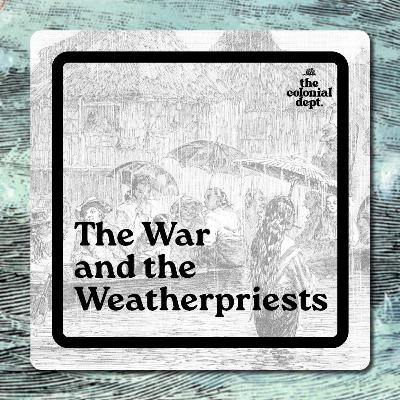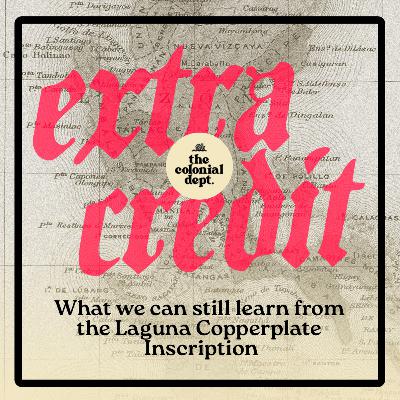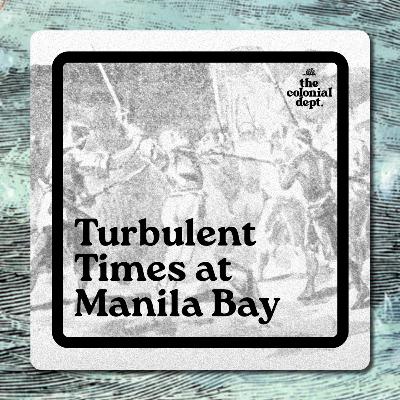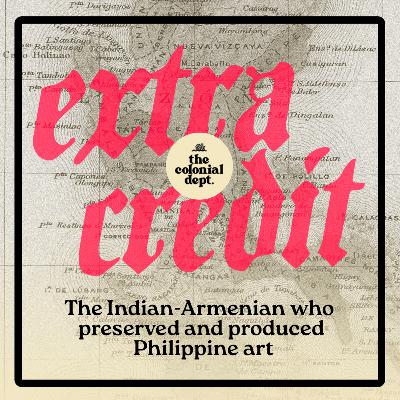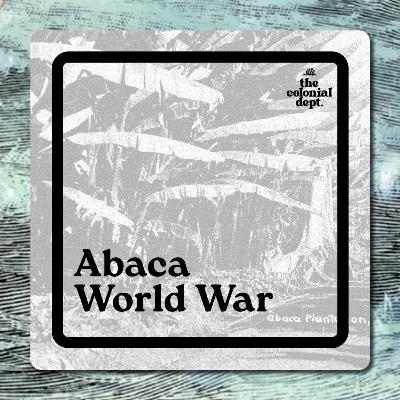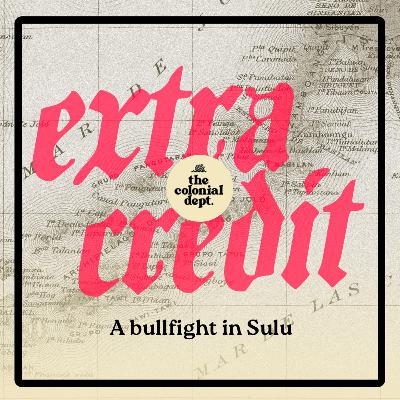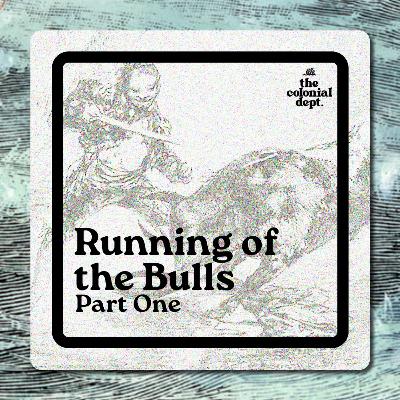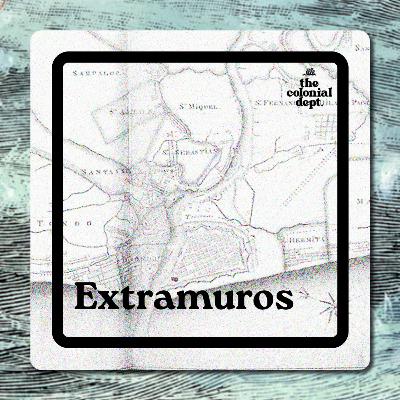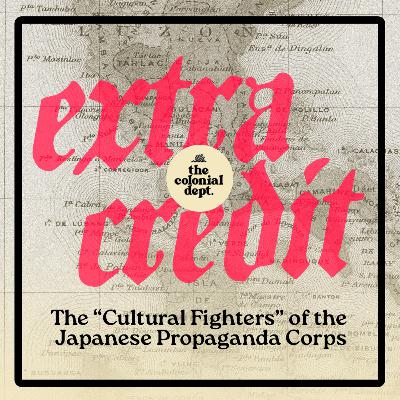Discover The Colonial Dept.
The Colonial Dept.

161 Episodes
Reverse
Ever since its founding in the 1860s, the Manila Observatory had stood watch against the typhoons and hurricanes that threatened to strike the Philippines. But decades later, they were unprepared for a different kind of approaching storm: the Second World War!Cover photo from the Illustrated London News.Additional audio from British Pathe. Follow us on IG: @thecolonialdeptFollow us on TikTok: @thecolonialdeptEmail us: thecolonialdept@gmail.comReferences:Warren, James Francis (2024). Typhoons: Climate, Society, and History in the Philippines. Ateneo de Manila University Press.Hidalgo, Angel (1967). “Miguel Selga, 1879-1956: Priest and Scientist.” Philippine Studies, 15(2), pp. 307-347.Bocar, Efren Cyril (19 November 2024). “‘Signs of disaster’: How weather lore holds up against typhoons and science.” Rappler. Biolong, Fr. Raymundus Rede, SVD (1996). “The Ivatan Cultural Adaptation to Typhoons: A Portrait of a Self-Reliant Community from the Indigenous Development Perspective.” Ribera, Pedro; García-Herrera, Ricardo; Gimeno, Luis (2008). “Historical deadly typhoons in the Philippines.” Weather, 63(7), pp. 194-199.
One of the Philippines’ most important archaeological finds, this thin sheet of metal still contains many mysteries. (Listen to S7E12 before listening to this one!)
In the late 1500s, sultans, kings, and outlaws alike all wanted a little slice of Manila. And over two turbulent decades, everyone from faraway Spain to neighboring Brunei asserted their claims over the rajahs and datus that lived there. This is the turbulent origin story of the city that we know today.Follow us on IG: @thecolonialdeptFollow us on TikTok: @thecolonialdeptEmail us: thecolonialdept@gmail.comCover photo from “Ataque de Li-ma-hong a Manila en 1574” by Juan Caro y MoraReferences:Patanne, E.P. (1993-1996). “Old Tondo and the Lakandula Revolt of 1574.”Historic Manila: Commemorative Lectures. Manila Historical Commission.Majul, Cesar Adib (1999). Muslims in the Philippines (third edition). University of the Philippines Press.Elsa Clavé, Arlo Griffiths (2022). “The Laguna Copperplate Inscription: Tenth-Century Luzon, Java, and the Malay World.” Philippine Studies: Historical and Ethnographic Viewpoints, 70(2), pp.167-242.Postma, Antoon (1992). “The Laguna Copper-Plate Inscription: Text and Commentary.”Philippine Studies, 40(2), pp. 183–203.“Paghinumdom: Retrospection of the Hindu-Buddhist Cultural Influences Based on Tangible Finds in the Caraga Region.” (2022) https://www.nationalmuseum.gov.ph/2022/09/30/paghinumdom-retrospection-of-the-hindu-buddhist-cultural-influences-based-on-tangible-finds-in-the-caraga-region/Velez, Genesis (2020). “Chinese Merchants in Late Pre-Hispanic Cebu: Context, Issues, and Possibilities.” Philippine Quarterly of Culture and Society, 48(3/4), pp. 125-155.Shutz, J. Travis (2019). “Limahong’s Pirates, Ming Mariners, and Early Sino-Spanish Relations: The Pangasinan Campaign of 1575 and Global History From Below.” Philippine Studies: Historical and Ethnographic Viewpoints, 67(3/4), pp. 315-342.
Born in Calcutta and in love with Philippine fashion, Rafael Daniel Baboom was a true partner in the creation of 19th-century Philippine art. (Listen to S7E11 before listening to this one!)
The nineteenth century—steamships, family names, world trade, foreign firms, liberal ideas. Great tides of change are roiling Manila. In the middle of the chaos, a new art trend captures the imagination of local elites. How are these letras y figuras holding a mirror to Philippine society?Cover Photo from the Ayala Corporation Collection.Follow us on IG: @thecolonialdeptFollow us on TikTok: @thecolonialdeptEmail us: thecolonialdept@gmail.comReferences:Blanco, John D. (2009). Frontier Constitutions: Christianity and Colonial Empire in the Nineteenth-Century Philippines. University of the Philippines Press.Santiago, Luciano P.R. (December 1991). “Damian Domingo and the First Philippine Art Academy.” Philippine Quarterly of Culture and Society, 19(4), pp. 264-280. Flores, Patrick D. (17 November 2011). “Everyday, Elsewhere: Allegory in Philippine Art.” Contemporary Aesthetics, (0)3 (Special Issue). “Lot 46. Jose Honorato Lozano, c. 1815-1885.” (2021) Salcedo Auctions. Quirino, Carlos (1961) "Damian Domingo, Filipino Painter." Philippine Studies: Historical and Ethnographic Viewpoints, 9(1), pp. 78-96.“Jose Honorato Lozano (c. 1815-c. 1885).” (undated) Christie’s.Sorilla IV, Franz (8 February 2021). “Letras y Figuras: The 19th Century Philippine Art Form’s Origins and Legacy.” Tatler Asia.Buenconsejo, Jose S. (2018). “Keyboards in the Nineteenth-Century Philippines.” In Tan, Arwin Q. (ed.), Saysay Himig: A Sourcebook on Philippine Music History, University of the Philippines Press, pp. 234-242.Navarro, Raul Casantusan. (2018). “Opera in the Philippines, 1860s-1940s.” In Tan, Arwin Q. (ed.), Saysay Himig: A Sourcebook on Philippine Music History, University of the Philippines Press, pp. 234-242.Mallat, Jean (1846). The Philippines: History, Geography, Customs, Agriculture, Industry, and Commerce of the Spanish Colonies in Oceania (Pura Santillan-Castrence, Trans.) (2021). National Historical Commission of the Philippines.
Tomas Claudio wasn’t the only Filipino who fought in the trenches of the Great War. Thousands of others also enlisted. (Listen to S7E10 before listening to this one!)
It was the Great War, the War to End All the Wars… and Philippine abaca merchants were raking in sky-high profits. The world’s most powerful navies relied on this plant—which is native to the Philippines—to keep their warships in battle-ready shape. But what the First World War giveth, the First World War also taketh away.Follow us on IG: @thecolonialdeptFollow us on TikTok: @thecolonialdeptEmail us: thecolonialdept@gmail.comReferences:Dacudao, Patricia Irene (2023). Abaca Frontier: The Socioeconomic and Cultural Transformation of Davao, 1898-1941. Ateneo de Manila University Press.Crapo, G.R. (February 1926). “The Philippine Fiber Industry.” Proceedings, 52(2). https://www.usni.org/magazines/proceedings/1926/february/philippine-fiber-industryLayton, J. Kent (undated). “Lusitania 100 years later: never forget.” National Museums Liverpool. https://www.liverpoolmuseums.org.uk/stories/lusitania-100-years-later-never-forgetJose, Ricardo Trota (1988). “The Philippine National Guard in World War I.” Philippine Studies, 36(3), pp. 275-299. https://www.jstor.org/stable/42633097Nagano, Yoshiko (2012). “The Philippine National Bank and Credit Inflation after World War I.” Global COE Hi-Stat Discussion Paper Series gd11-216, Institute of Economic Research, Hitotsubashi University.Ybiernas, Vicente Angel (2012) "Philippine Financial Standing in 1921: The First World War Boom and Bust." Philippine Studies, 55(3), pp. 345-372.
A story of a Philippine bullfight…in the unlikeliest place of alll! (Listen to S7E8 and S7E9 before listening to this one!)
In the second part of our look at the lost sport of Philippine bullfighting, we go deep into its heyday in the 1800s, with social clubs, provincial arenas, and matadors with nicknames like “Fatiguitas.”Then, we look at how and why bullfighting faded away in our archipelago.Follow us on IG: @thecolonialdeptFollow us on TikTok: @thecolonialdeptEmail us: thecolonialdept@gmail.comReferences:Vibal, Gaspar (2022). Bullfighting in the Philippines, 1602-2022. Vibal Books. Cornwell, Zach (Host). (13 December 2021). “Gore: The Brutal History of Bullfighting” [Audio podcast episode]. In Conflicted, Evergreen Podcast.Amano, N., Bankoff, G., Findley, D. M., Barretto-Tesoro, G., & Roberts, P. (2020). “Archaeological and historical insights into the ecological impacts of pre-colonial and colonial introductions into the Philippine Archipelago.” The Holocene, 31(2), pp. 313-330. https://doi.org/10.1177/0959683620941152Mudar, Karen (1997). “Patterns of Animal Utilization in the Holocene of the Philippines: A Comparison of Faunal Samples from Four Archaeological Sites.” Asian Perspectives, 36(1), pp. 67-105.Davis, Janet M. (2013) “Cockfight Nationalism: Blood Sport and the Moral Politics of American Empire and Nation Building.” American Quarterly, 65(3), pp. 549-574.
In fiestas in a bygone age, the corrida de toros—the coursing of the bulls—would always be part of the festivities and celebrations in town plazas across the Philippines. Why did this tradition disappear from our shores?In this two-part episode, we examine the history of bullfighting in the Philippines. In Part One, join Antonio Luna as he watches his first bullfight… and then travel back in time to the very start of the Spanish occupation, when the fiesta de toros became a fixture in our holidays!Follow us on IG: @thecolonialdeptFollow us on TikTok: @thecolonialdeptEmail us: thecolonialdept@gmail.comReferences:Vibal, Gaspar (2022). Bullfighting in the Philippines, 1602-2022. Vibal Books. Hemingway, Ernest (1927). Fiesta; or, The Sun Also Rises. Jonathan Cape Ltd.Hartwell, Rafael Ernest (2019). “Bad English and Fresh Spaniards: Translation and Authority in Philippine and Cuban Travel Writing.” Unitas, 92(1), pp. 43-74.Cornwell, Zach (Host). (13 December 2021). “Gore: The Brutal History of Bullfighting” [Audio podcast episode]. In Conflicted, Evergreen Podcast.
We know it now as the place where Rizal was executed, but the history of Bagumbayan reaches back centuries! (Listen to S7E7 before listening to this one!)
For centuries, Spain ruled the Philippines from within the closed, claustrophobic walls of Intramuros—the walled city of Manila. But right outside these walls, Manila, too, grew and developed, following the contours of migration, enterprise, and yes, even conflict. Let’s track the evolution of the districts and arrabales outside the walls, or extramuros.Follow us on IG: @thecolonialdeptFollow us on TikTok: @thecolonialdeptEmail us: thecolonialdept@gmail.comReferences:Camagay, Ma. Luisa (1993-1996). “Urban Development of Manila During the 19th Century.” In Victoriano, Enrique L. (ed.), Historic Manila: Commemorative Lectures, Manila Historical Commission.Wise, Edwin (2019). Manila, City of Islands. Ateneo de Manila University Press.Eng Sin Kueh, Joshua (2014). The Manila Chinese: Community, Trade, and Empire, c. 1570-1770 [doctoral dissertation]. Georgetown University.Fish, Shirley (2003). When Britain Ruled the Philippines, 1762-1764: The Story of the 18th Century British Invasion of the Philippines During the Seven Years War. FirstBooks Library.Banyard, Laurence (16 May 2025). “Manila Port City – A Story of Mutual Interdependence and Competing Self-interest.” PortCityFutures. https://www.portcityfutures.nl/news/manila-port-city-a-story-of-mutual-interdependence-and-competing-self-interestCubeiro, Didac (2017). “Modernizing the Colony: Ports in Colonial Philippines, 1880-1908.” World History Connected. https://worldhistoryconnected.press.uillinois.edu/14.3/forum_cubeiro.htmlEnano, Jhesset O. (25 June 2019). “Metro Manila’s green spaces continue to shrink.” Philippine Daily Inquirer. https://newsinfo.inquirer.net/1133654/metro-manilas-green-spaces-continue-to-shrinkDe Villa, Kathleen (1 May 2025). “21 Manila Bay reclamation projects equal area of 2 cities.” Philippine Daily Inquirer. https://newsinfo.inquirer.net/2057082/21-manila-bay-reclamation-projects-equal-area-of-2-cities
A brief look at the team of novelists, poets, painters, cameramen, filmmakers, and other creatives who invaded the Philippines as part of the Propaganda Corps. (Listen to S7E6 before listening to this one!)
Beyond the bullets, the tanks, the planes, the bombs, the Japanese also brought other weapons to bear against the Filipinos: Typewriters. Radio waves. Movie theaters.Here is one story from the frontlines of shisōsen, or "the thought war."Follow us on IG: @thecolonialdeptFollow us on TikTok: @thecolonialdeptEmail us: thecolonialdept@gmail.comReferences:Campoamor II, Gonzalo (2017). “Re-Examining Japanese Wartime Intellectuals: Kiyoshi Miki during the Japanese Occupation of the Philippines.” Asian Studies: Journal of Critical Perspectives on Asia, 53(1), pp. 1-38.Terami-Wada, Motoe (1990). “The Japanese Propaganda Corps in the Philippines.” Philippine Studies, 38(3), pp. 279-300.Lagmay, Alfred (1977). “Bahala Na!” In Pe-Pua, Rogelio (ed., 2018), Handbuk ng Sikolohiyang Pilipino, Bolyum I: Perspektibo at Metodolohiya, University of the Philippines Press.Jose, Ricardo T. (1998). The Japanese Occupation. In Kasaysayan: The Story of the Filipino People. Asia Publishing Company Limited.Griggs, Alyson (2020). There Were Children on the Battleground: Japanese and Filipino Youth in the Second World War [masteral dissertation]. Utah State University.
From the Panlilios of Pampanga to future gangster Jack Riley, Tom’s Dixie Kitchen pops up in the biographies of some unexpected people. (Listen to S7E5 before listening to this one!)
Governors and gangsters, spies and socialites—it seemed that all of Manila dined out at the two-floor restaurant that rose above the bustle of Plaza Goiti. Inside, waiters handed you menus with more than three hundred dishes on offer, and, for special guests, directed you to special themed dining rooms upstairs. But there was enough entertainment on the first floor. There was a jazz band playing live music. There was a boxing promoter hamming it up at the next table. There was a steady stream of VIPs coming in through the front door.This is the story of Tom’s Dixie Kitchen.Follow us on IG: @thecolonialdeptFollow us on TikTok: @thecolonialdeptEmail us: thecolonialdept@gmail.comReferences:Manila Electric Co. (1932). “City of Manila and Suburbs [map].”Mount, Guy Emerson (2018). “Soul Food, Stir Fry, and Citizenship.” In Mount, The Last Reconstruction: Slavery, Emancipation, and Empire in the Black Pacific [doctoral dissertation], The University of Chicago.Mount, Guy Emerson (2018). “An Open Door: The Geopolitical Possibilities and Pitfalls of Black Colonization to the Pacific.” In Mount, The Last Reconstruction: Slavery, Emancipation, and Empire in the Black Pacific [doctoral dissertation], The University of Chicago.Ngozi-Brown, Scot (1997). “African-American Soldiers and Filipinos: Racial Imperialism, Jim Crow and Social Relations.” The Journal of Negro History, 82(1), pp. 42-53.Lee, Ira (17 March 2020). “How Racism Pushed This U.S. Soldier to Join Filipino Guerrillas.” Esquire Philippines. Department of Agricultural and Commerce (1934). Philippine Statistical Review. Bureau of Printing.Pritchard vs. Republic, Case Digest (G.R. No. L-1715) (1948).
“Peste general.” “Pestilencial epidemia.” “Epidemia maligna.” In the Philippine archipelago, Spanish chroniclers wrote of deadly epidemics that struck their new possession. (Listen to S7E4 before this one.)
Crucial to the story of coffee in the Philippines is the industry’s boom years in Lipa during the late 1800s. What really happened then? (Listen to S7E3 before this one.)
Coffee. Tea. Cocoa. The three have a surprisingly rich, complex, and layered history in the Philippines. How did they arrive here, and what effect did they have in the archipelago’s colonial period?Follow us on IG: @thecolonialdeptFollow us on TikTok: @thecolonialdeptEmail us: thecolonialdept@gmail.comThanks to Beach Reads Book Club (based in The Beach House cafe in Kapitolyo) for hosting the live premiere of this episode last July 5. References:Acabado, Stephen (4 May 2025). “[Time Trowel] A drunk history of the Philippines.” Rappler. https://www.rappler.com/voices/thought-leaders/time-trowel-drunk-history-philippines/Edgar, Blake (2010). “The Power of Chocolate.” Archaeology, 63(6), pp. 20-25. https://www.jstor.org/stable/41780626Doeppers, Daniel (2016). Feeding Manila in Peace and War, 1850-1945. Ateneo de Manila University Press.Topik, Steven (2003). The World Coffee Market in the Eighteenth and Nineteenth Centuries, from Colonial to National Regimes. GEHN Conference, Bankside, London.Sonnad, Nikhil (11 January 2018). “Tea if by sea, cha if by land: Why the world only has two words for tea.” Vox.Chia, Lucille (2006). “The Butcher, the Baker, and the Carpenter: Chinese Sojourners in the Spanish Philippines and Their Impact on Southern Fujian (Sixteenth-Eighteenth Centuries).” Journal of the Economic and Social History of the Orient, 49(4), pp. 509-534.Lanzona, Claudine (2019). “The Search Party.” Grid. “Cocoa (cacao).” (n.d.) Plant Village. https://plantvillage.psu.edu/topics/cocoa-cacao/infosCrawford, John (1852). “History of Coffee.” Journal of the Statistical Society of London, 15(1), pp. 50-58.
This faraway empire shows up in unexpected pages of our history. (Listen to S7E2 before this one.)


